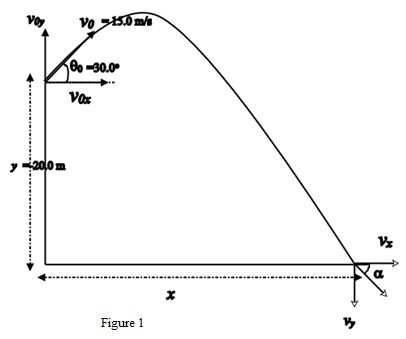
Concept explainers
(a)
The time taken by the rock thrown from the edge of a cliff to reach the ground.
(a)
Answer to Problem 50P
The rock takes 2.93 s to reach the ground.
Explanation of Solution
Given:
The depth of the ground from the top of the cliff,
Velocity of projection
,
Angle of projection,
Formula used:
The time taken to reach the ground is determined using the expression
Here,
Calculation:
The path of the rock is shown in the diagram below:

Calculate the value of
Substitute the values of variables in equation (1).
Rewrite the equation as follows:
Solve the quadratic equation.
Take the positive root, since time cannot have a negative value.
Conclusion:
Thus, the rock takes 2.93 s to reach the ground.
(b)
The horizontal distance between the point of projection and the point where the rock lands on the ground.
(b)
Answer to Problem 50P
The rock lands at a horizontal distance of 38.1 m from the point of projection.
Explanation of Solution
Given:
Velocity of projection,
Angle of projection,
Time of flight of the rock,
Formula used:
The horizontal component of the rock’s velocity is constant, since no force acts on the rock in the horizontal direction in the absence of air resistance.
The horizontal distance travelled by the rock in a time t is given by,
Here, the horizontal component
Calculation:
Substitute the given values in equation (4) and calculate the value of
Substitute the values of
Conclusion:
Thus, the rock lands at a horizontal distance of 38.1 m from the point of projection.
(c)
The velocity of the rock when it lands on the ground.
(c)
Answer to Problem 50P
The velocity of the rock when it lands on the ground is found to have a magnitude
Explanation of Solution
Given:
The horizontal component of the rock’s initial velocity,
The vertical component of the rock’s initial velocity,
Time of flight of the rock,
Formula used:
The vertical component of the rock’s velocity when it reaches the ground is given by the expression,
The horizontal component of the rock’s velocity when it reaches the ground remains unchanged during its motion. Therefore,
The magnitude of the velocity of the particle when it reaches the ground is given by,
The angle made by the velocity vector to the horizontal is given by the expression,
Calculation:
Calculate the vertical component of the rock’s velocity when it reaches the ground by substituting the values of the variables in equation (5).
Since
Substitute the values of
Substitute the values of
Conclusion:
Thus the velocity of the rock when it lands on the ground is found to have a magnitude
Want to see more full solutions like this?
Chapter 3 Solutions
EBK PHYSICS FUNDAMENTALS
- A sniper atop a building 150m high fired a bullet parallel to the horizontal with a speed of 1800km/h. How long will it take the bullet to reach the ground?arrow_forwardA projectile is launched with an initial speed of 23.4m/s at an angle of 36.4 degrees with respect to the horizontal. How long does it take the object to move a distance of 32.9 meters in the x direction?arrow_forwardA projectile is launched in the horizontal direction. It travels 2.050m horizontally while it falls 0.450m vertically, and it then strikes the floor. How long is the projectile in the air? What was the original velocity of the projectile?arrow_forward
- A ball is thrown with an initial velocity of 80 ft/s at an angle of 38 degree above the horizontal from a point 192 ft from the edge of a vertical cliff 160 ft high, the ball just misses the edge of the cliff. At what distance beyond the foot of the cliff where the ball strikes the ground?arrow_forwardA brick is thrown upward from the top of a building at an angle of 30° to the horizontal and with an initial speed of 13 m/s. If the brick is in flight for 3.3 s, how tall is the building?arrow_forwardA cannonball is shot (from ground level) with an initial horizontal velocity of 39 m/s and an initial vertical velocity of 30 m/s. How far from where it was shot will the cannonball land?arrow_forward
- A baseball is struck by a batter and leaves the bat at an angle of 42° from the right horizontal and an initial velocity of 49 m/s (also known as exit velocity) at a height of 1.6m from the ground. How far has the ball traveled, horizontally, when it returns to 1.6 m above ground?arrow_forwardA projectile is shot from the edge of a cliff 140m above ground with an initial speed of 80 m/s at an angle 24 degrees below the horizontal. How much time does it take the projectile to hit the ground?arrow_forwardThe best leaper in the animal kingdom is the puma, which can jump to a height of 12.7 ft when leaving the ground at an angle of 50°. With what speed, in SI units, must the animal leave the ground to reach that height?arrow_forward
 College PhysicsPhysicsISBN:9781305952300Author:Raymond A. Serway, Chris VuillePublisher:Cengage Learning
College PhysicsPhysicsISBN:9781305952300Author:Raymond A. Serway, Chris VuillePublisher:Cengage Learning University Physics (14th Edition)PhysicsISBN:9780133969290Author:Hugh D. Young, Roger A. FreedmanPublisher:PEARSON
University Physics (14th Edition)PhysicsISBN:9780133969290Author:Hugh D. Young, Roger A. FreedmanPublisher:PEARSON Introduction To Quantum MechanicsPhysicsISBN:9781107189638Author:Griffiths, David J., Schroeter, Darrell F.Publisher:Cambridge University Press
Introduction To Quantum MechanicsPhysicsISBN:9781107189638Author:Griffiths, David J., Schroeter, Darrell F.Publisher:Cambridge University Press Physics for Scientists and EngineersPhysicsISBN:9781337553278Author:Raymond A. Serway, John W. JewettPublisher:Cengage Learning
Physics for Scientists and EngineersPhysicsISBN:9781337553278Author:Raymond A. Serway, John W. JewettPublisher:Cengage Learning Lecture- Tutorials for Introductory AstronomyPhysicsISBN:9780321820464Author:Edward E. Prather, Tim P. Slater, Jeff P. Adams, Gina BrissendenPublisher:Addison-Wesley
Lecture- Tutorials for Introductory AstronomyPhysicsISBN:9780321820464Author:Edward E. Prather, Tim P. Slater, Jeff P. Adams, Gina BrissendenPublisher:Addison-Wesley College Physics: A Strategic Approach (4th Editio...PhysicsISBN:9780134609034Author:Randall D. Knight (Professor Emeritus), Brian Jones, Stuart FieldPublisher:PEARSON
College Physics: A Strategic Approach (4th Editio...PhysicsISBN:9780134609034Author:Randall D. Knight (Professor Emeritus), Brian Jones, Stuart FieldPublisher:PEARSON





